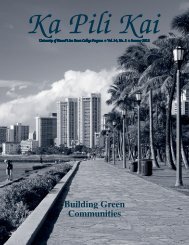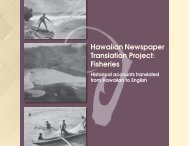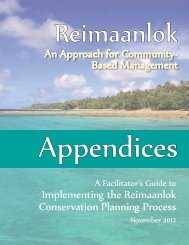2011 Environmental Product Guide - Sea Grant College Program
2011 Environmental Product Guide - Sea Grant College Program
2011 Environmental Product Guide - Sea Grant College Program
Create successful ePaper yourself
Turn your PDF publications into a flip-book with our unique Google optimized e-Paper software.
DEFINITIONS (cont.)Return to Table Of ContentsNNAIMA: North American Insulation Manufacturers AssociationNAUF or NAF: No Added Ureea-FormaldehydeNEMA 250: National Electrical Manufacturers AssociationNGBS: National Green Building Standardshttp://www.nahbgreen.org/NPDES: National Pollutant Discharge Elimination Systemhttp://cfpub.epa.gov/npdes/NWFA: National Wood Flooring AssociationOO & M: Operation & MaintenanceOTA: Organic Trade Association is a membership-basedbusiness association that focuses on the organic businesscommunity in North America. OTA’s mission is to promoteand protect the growth of organic trade to benefit theenvironment, farmers, the public and the economy.http://www.ota.com/about/accomplishments.htmlOZONE DEPLETION POTENTIAL (ODP): Relative value thatindicates the potential of a substance to destroy ozone gas ascompared with the potential of chlorofluorocarbon-11 (CFC-11)which is assigned a reference value of 1. Thus, a substancewith ODP of 2 is twice as harmful as CFC-11.ODS: Ozone Depleting Substances.PPEHD: Polyethylene High-DensityPETROCHEMICALS: Chemical products processed frompetroleum, a finite resource that is energy-intensive andpolluting to extract, ship, and process.POLYCARBONATE: Any of a class of thermoplasticscharacterized by high-impact strength, light weight, andflexibility, and used as shatter-resistant substitutes for glass.POLYETHYLENE HIGH-DENSITY (PEHD): See High-DensityPolyethylenePOLYVINYL CHLORIDE (PVC): A common thermoplastic resin,used in a wide variety of manufactured products, includingrainwear, garden hoses, phonograph records, and floor tiles.The chemicals in PVC can cause cancer, birth defects, geneticchanges, chronic bronchitis, ulcers, skin diseases, deafness,vision failure, indigestion, and liver dysfunction.POST-CONSUMER/POST-INDUSTRIAL RECYCLED CONTENT:is typically measured by percentage of recycled content byweight.POST-CONSUMER recycled materials are more likely to bediverted from landfills and are considered environmentallypreferrable to post industrial recycled materials.POST-INDUSTRIAL OR PRE-CONSUMER recycled materials arederived from the manufacturing waste.PPM: Parts Per MillionRR-VALUE: A measure of a material’s resistance to heat flow. Ahigher R-value indicates a higher insulating capacity. Increasingthe R-value of a roof assembly will help keep interior spaces coolby resisting the transfer of solar heat. R-value is also the inverseof a material’s U-value.RAMMED EARTH: A construction technique that utilizes earthenmixture from the building site that is then “rammed” intoformwork to create walls.RAPIDLY RENEWABLE PRODUCTS: Have a harvesting rotation oftypically less than 10 years and are often agricultural crops.RENEWABLE ENERGY: Energy that comes from natural sources.Includes solar water heaters, photovoltaic systems, and windturbines.R-PET: Recycled Polyethylene TerephthalateRESNET: Residential Energy Services Networkhttp://www.resnet.us/professionalROHS: Restriction of Hazardous Substances, European Uniondirective to restrict hazardous materials in electronic andelectrical equipment.SSALVAGED MATERIALS: Typically sold by regional salvage yards,helps to reduce demand for raw materials.SEASONAL ENERGY EFFICIENCY RATING (SEER): A rating systemthat evaluates the efficiency of equipment and products. Thehigher the rating, the higher the efficiency.14
















